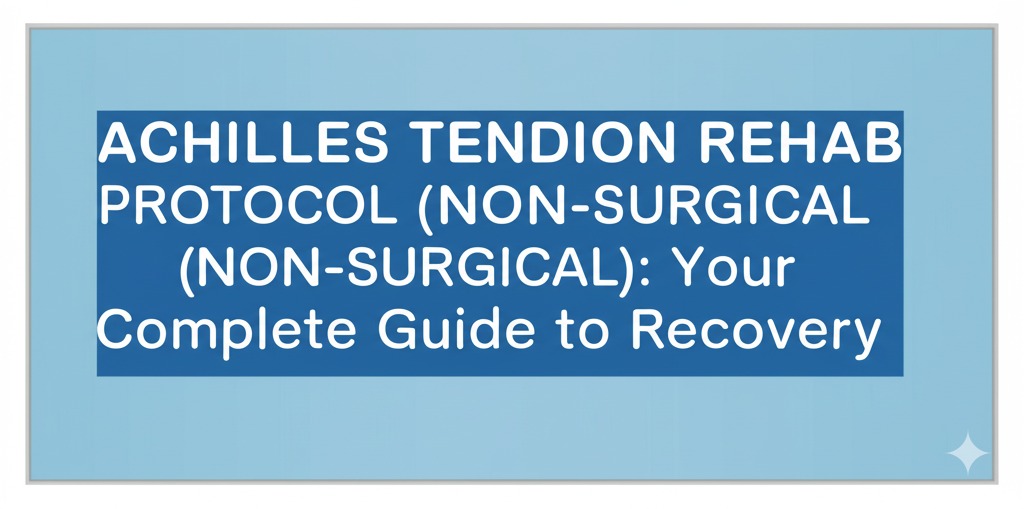The Achilles tendon is the largest and strongest tendon in the human body, but when injured, especially without surgery, proper rehabilitation is crucial. Whether you’re an athlete or an active individual, understanding the non-surgical rehab protocol for an Achilles tendon injury can mean the difference between a full recovery and chronic issues.
In this guide, we’ll walk you through everything you need to know about non-surgical Achilles tendon rehab, from the initial rest phase to advanced strengthening and return-to-activity strategies.
What Is a Non-Surgical Achilles Tendon Injury Rehab Protocol?
A non-surgical rehab protocol is a structured treatment plan designed for patients with a partial Achilles tendon tear or rupture who opt out of surgery. This approach is often recommended for:
- Less severe tears or ruptures
- Older or less active individuals
- Patients with medical conditions that increase surgical risks
With proper guidance and commitment, non-surgical rehab can be just as effective as surgical treatment.
Phases of Achilles Tendon Rehab (Non-Surgical Approach)
Phase 1: Acute Phase (0–2 Weeks)
Goal: Protect the tendon and reduce inflammation.
- Rest and elevate the foot
- Use crutches to avoid weight-bearing
- Immobilize with a boot in plantarflexion (foot pointed down)
- Apply ice 15–20 minutes several times a day
- Start gentle range-of-motion (ROM) exercises (if approved by your physician)
Key Tip: Early immobilization is critical to allow tendon healing and reduce risk of rerupture.
Phase 2: Early Recovery (2–6 Weeks)
Goal: Begin gentle mobility and gradually reintroduce weight-bearing.
- Transition from crutches to partial weight-bearing as tolerated
- Continue using a boot with gradual adjustments toward neutral foot position
- Begin active ROM exercises: ankle pumps, circles
- Start isometric strengthening for calf muscles
Important: Follow your physical therapist’s timeline carefully. Too much stress too soon can delay healing.
Phase 3: Intermediate Strengthening (6–12 Weeks)
Goal: Restore strength, balance, and full range of motion.
- Discontinue boot (if cleared by doctor)
- Begin resistance band exercises for plantarflexion, dorsiflexion, inversion, and eversion
- Add heel raises (double-leg to single-leg progression)
- Integrate balance training using wobble boards or stability balls
Pro Tip: Keep monitoring for swelling and soreness—these can be signs you’re progressing too quickly.
Phase 4: Advanced Rehab (3–6 Months)
Goal: Return to higher-level activities and sports.
- Introduce plyometric exercises (jumping, bounding)
- Begin light jogging and agility drills
- Focus on eccentric calf strengthening (slow heel drops)
- Include sport-specific training tailored to your goals
Reminder: Progress should be gradual. Don’t rush into high-impact activities until cleared by your healthcare provider.
Phase 5: Return to Activity (6 Months and Beyond)
Goal: Safely return to full, unrestricted activity.
- Full participation in sports or physical work
- Ongoing maintenance exercises for calf strength and flexibility
- Continue dynamic warm-ups and cool-downs to prevent reinjury
Success Tip: Even after rehab, regular strengthening and stretching are key to preventing future injuries.
Additional Tips for a Successful Non-Surgical Recovery
- Stay consistent with your rehab plan—skipping sessions can delay healing
- Work closely with your physical therapist and follow their guidance
- Maintain good nutrition and hydration to support tissue repair
- Don’t ignore pain—let your provider know if symptoms worsen
- Stay patient—full recovery may take 6–12 months
Final Thoughts: You Can Recover Without Surgery
Recovering from an Achilles tendon injury without surgery is entirely possible with a structured protocol and dedicated effort. By following each phase carefully, listening to your body, and working with professionals, you can regain your strength, mobility, and confidence.

Kallie Snyder is an author at Stonegate Health Rehab, providing valuable insights, recovery guidance, and rehab resources to help individuals achieve better health and well-being.
